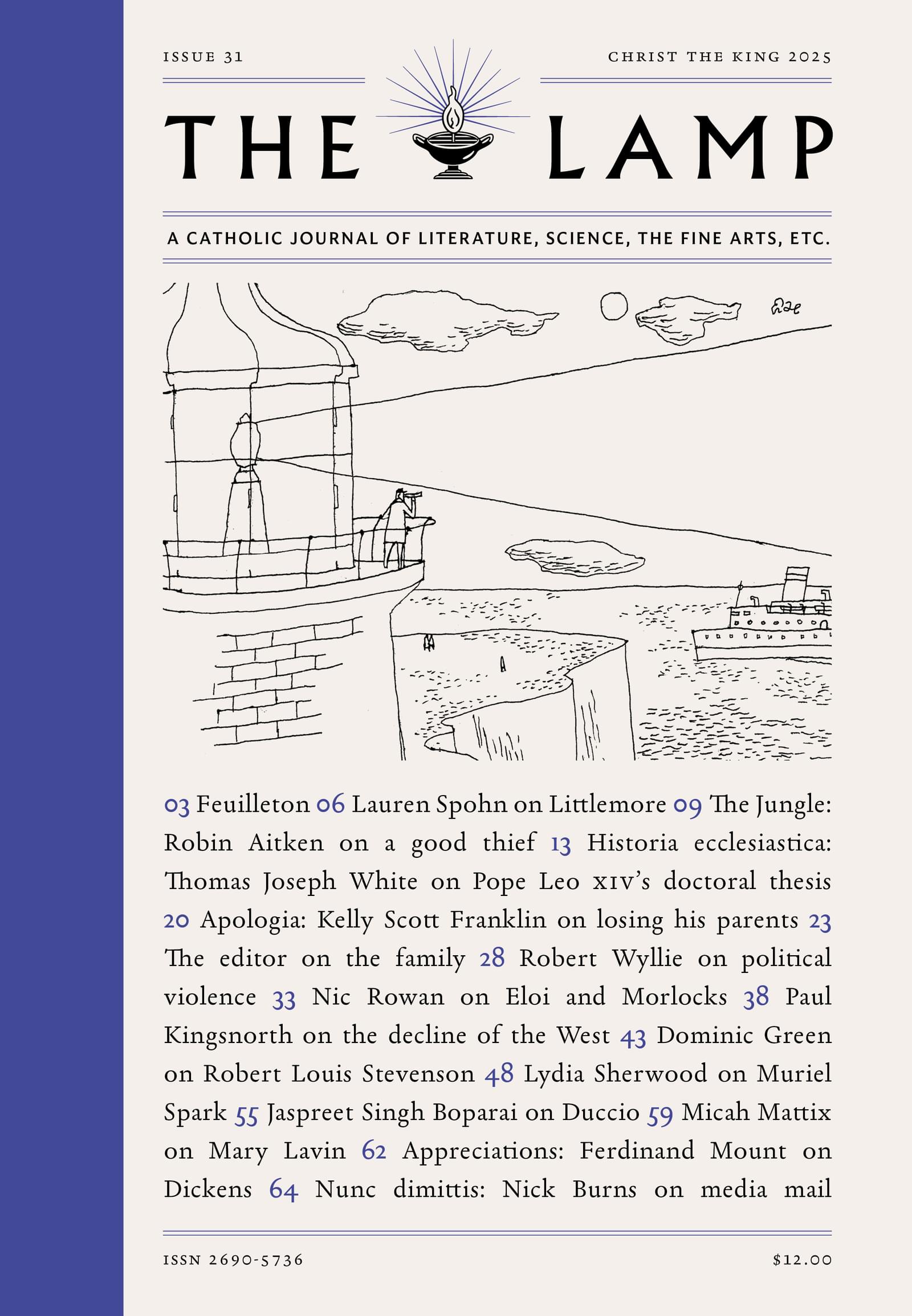Arts and Letters
Momsplaining
Mom Genes: Inside the New Science of Our Ancient Maternal Instinct, by Abigail Tucker
Momsplaining
Mom Genes: Inside the New Science of Our Ancient Maternal Instinct
Abigail Tucker
Gallery, pp.336, $28.00
This summer my husband ought to have been celebrating seven years of above-average headship. As I glance over the gradebook it’s the middling scores that pull at his excellence—there are very few failures. And yet, six years ago, when the whole steering of the ship was still a new thing, my husband failed me. “Maybe I should go to one of those parenting classes,” I said about halfway through my first pregnancy. “You do not need to go to a stupid parenting class. You are going to be a great mother. It will come naturally.”
I had never held a baby, never put on a diaper, never strapped anyone into a car seat, never babysat anyone under the age of five. I was an only child. I thought that normal babies slept through the night. I didn’t know the different ways to soothe an infant. We were four states away from any family. I was twenty-two. I had no friends who were moms. I read one terrible book. (In case you are looking for anti-recommendations, this was The Baby Whisperer, which took for granted that you knew plenty of things already and gave very bad and very English advice about the all-consuming importance of schedules). Will and determination have carried me my whole life; they did not help me put my angry, colicky newborn to bed. I could have avoided some anguish if I had taken that stupid class.
Now four children in to this thing of ours I can confidently say that the doing of it is a skill learned like any other. There is no Good Mothering book downloaded into our brains during pregnancy. The correct answer will not magically occur to us at two a.m. Yet there is something that has changed about me. I don’t know if “natural” or “instinct” are the right descriptive words here, but I will say that the love required, the laying down of my life, the abdication of my desires—these have all come to me without my looking for it. Thank God. Love is much harder to cultivate than a knowledge of diapering and feeding.
Abigail Tucker has written a new book entitled Mom Genes: Inside the New Science of Our Ancient Maternal Instinct. Previously she wrote a bestseller about house cats. “Mom science,” as she calls it, has long been neglected by the scientific community, but it has recently enjoyed a bit of a boom. Cynical me thinks it might have something to do with new “mom drugs’’ aimed at postpartum depression. (The first-of-its-kind F.D.A.-approved Zulresso is I.V.-dripped over sixty continuous hours and costs thirty-four thousand dollars). In my rare romantic moments—my husband seems to have more of them than I do—I hope it is happening because as we look closely we are dazzled by the strangeness of the whole mom thing.
There are two definitions of “maternal instinct” in Tucker’s book. The first, which applies to animals, is compulsory and easy to identify: rats lick their babies, rabbits make comfy nests with their belly fuzz, ewes memorize their lambs’ scents, the burying beetle shoves “the whole wriggling baby into her own open jaws like a foot-long sandwich” to eat when there isn’t enough rotting mouse carcass for everyone. Human moms have to learn everything. “Even that definitive mammalian behavior, nursing, varies wildly among our kind. . . . If it were so natural, so deeply ingrained and instinctive, why would we need a four-hundred-page brick of a bestselling manual on the ‘womanly art of breastfeeding’?” When Tucker talks about the human maternal instinct, what she is referring to is not a change in action, but in mind. “Infant-centric pleasure, heightened sensitivity to baby cues, and bullheaded motivation make up the heart of a new mother’s instinctive awakening.”
I don’t want to spend too much time wondering whether what Tucker is describing about human moms actually qualifies as an instinct. And I don’t want to waste your time with my own musings about whether human beings have instincts at all. (I am no philosopher.) But it occurred to me, almost immediately, that the scientific research devoted to animal moms and the human-focused variety could not be less congruent. I know this is a popular science book, but I need more of an explanation than “Across the whole mammalian family, hamster moms and wallaby moms and human moms are all kindled by a common spark.” This “spark” is our shared pattern of hormones (at least I think that’s what Tucker means here), but wallabies, in addition to having some of the same chemicals as me, uniquely have two uteruses and are pregnant for their entire adult lives. And hamster moms routinely eat their young, a fact I know Tucker knows because one of the funniest parts of this book is her kid’s hamster eating her babies. I resent this underpinning of materialism. Possibly one is not allowed to write a science-y book without it, but isn’t motherhood one of our best shots at pushing back?
Mom Genes has topical chapters in which Tucker layers her autobiographical experience as a mother of four, human “mom-science,” and animal “mom-science,” with the occasional journalism as she visits labs all over the United States. The autobiographical sections are the best parts of the book. She is honest and vivid and funny. Very funny. At first I audibly groaned at the portmanteaus and puns—“momsplain,” “momster,” “momentum,” “thermometers”—but by the end I chuckled appreciatively at each one. The hamster bit is funny. There are also lots of fat mom jokes—not “your mama” jokes, but jabby little asides, like “Finally, folks who appreciate a plump mom.” There are at least twenty of these and at first they made me uncomfortable, because I carry a bit after having four under five (the oldest will be six when this is published), but by the end of the book they made me smile.
Tucker does a very good job of weaving together all the disparate threads, though there is the occasional awkward transition (“Human mothers are not just giant hairless two-legged rats . . . scrounging for the last scrap of cheese in the fridge”: One hopes not). And even though learning about mammalian moms didn’t alter my views about my own experience, I was interested to learn that
Other mammals spend far less time nursing their young. For wild rabbits, with their rich milk, it’s about five minutes a day. Fur seals may nurse only once a week.
I was also horrified by Tucker’s description of experiments on rat-moms meant to show what might curb their devotion. “She will brave an electric grid to reach pups,” we are told. “You can blind her, deafen her, muzzle her, amputate her nipples, disable her nose, even burn off certain bits of her brain. You can trap her babies in a glass bottle.” She still tries to succor them. Let’s have a moment of silence for the graduate student who had to cut off rat nipples.
Since I have poo-pooed a bit already, I should confess my biases. Neuroimaging doesn’t hold very much water for me. The brain communicates with electrical pulses. These pulses make the machine light up. And so what? It reminds me of the old men with their metal detectors who are certain that every beep-beep will lead to a valuable ring or coin. The machines indicate that mothers respond in particular ways to their own children. “We don’t really need neuroimaging to tell us this, but it does,” someone called Linda Mayes of Yale University’s Child Study Center is quoted as saying. Linda, I couldn’t agree with you more. Much of the neuroimaging stuff in Mom Genes is like this. Scientists use technology to “confirm” what we already know. (Would it surprise you, reader, to learn that men do not find baby faces as compelling as women do?) But maybe I should be more sympathetic. Our speculations about the human person have become so silly in recent years that maybe we need the Lite-Brite to tell us things no one would have disagreed with before roughly five seconds ago historically speaking.
Some of the new research in Mom Genes is fascinating. The placenta, long thought of by me as the miraculous organ a woman’s body makes to sustain her baby, is actually the biological representative of the father, containing many of his genes. It begins by “peeling off from the outside of the barely there fetal clump,” just five days after gestation and immediately “bypasses the woman’s brain and takes the reins, messaging her ovaries directly for more and more progesterone, so that her pregnancy-preventing period never comes.” Placental cells then attack arteries to redirect blood. An incredible amount is needed to grow the baby’s brain. These zealous cells help explain why postpartum hemorrhage is so common in women but mostly absent for all other mammals. The placenta also initiates much of the hormonal change that takes place during pregnancy. It is not completely understood, and according to Tucker, “scientists suspect that the imprinted dad genes are driven to maximize maternal care.”
There is also new research that builds on the discovery of mom and baby’s sharing of D.N.A. and cells. Tucker mentions the famous case (famous to those of us interested in these sorts of things, anyway), in which a woman’s liver damaged by hepatitis C was able to grow an entire new lobe thanks to her son’s cells still living in her. The strange part: she had no living son, just the memory as it were of his abortion. Every child a woman carries leaves a part of him or herself inside her. On occasion this can lead to problems, but it can be beneficial too. “One decade-long Dutch study tracked 190 women in their fifties and sixties, and those with detectable leftover baby cells were less likely to die of virtually everything.” I wonder when one of our theologians will write a book about the Marian implications of all this. (I am not a theologian, but if this suggestion gives rise to more learned speculations, do remember to acknowledge a simple housewife from the Midwest).
In her introduction Tucker writes: “I want to know what rocks the hand that rocks the cradle.” We never quite return to that “what.” Tucker talks about the hand, the cradle, and the rocking. She tells us a great deal about the how, but very little about the “what.” And that is because science doesn’t really tell us about that kind of thing. Science depends upon an increasingly narrow definition of reason, and love defies what is reasonable. At best our methods tell us about the symptoms of its failure.
Still, I enjoyed reading Mom Genes. Here is a very good snapshot of what science is up to these days. The book is admirably free of the new woke language; no “birthing person,” “chestfeeding,” “body-feeding,” “them,” “cisgender.” Tucker should be congratulated for this. I like her personality on the page, her enthusiasm for her subject, and her goofiness. I wish that she had been able to write a book more focused on her own experiences, which I suspect might have told us a bit more about that mysterious “what.”
Lydia Sherwood has written for the Washington Free Beacon, the American Spectator, and other publications.




